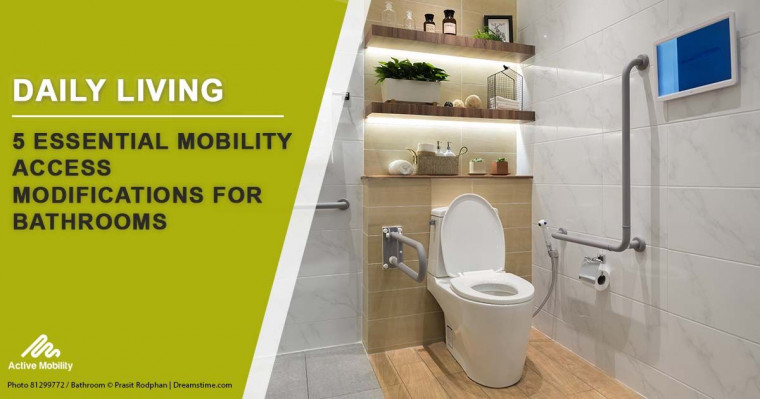-
Australia
Copyright © 2025 Powered by BCI Media Group Pty Ltd
Confirm Submission
Are you sure want to adding all Products to your Library?
Contact Detail

Whether you’re planning a new home build, a bathroom renovation or restoration, it’s important to tick all the boxes and ensure your bathroom meets all of your accessibility needs.
But what kind of home modifications for disability are recommended? What’s missing from your bathroom design?
Here, we share five mobility access modifications to make your bathroom more accessible and secure.
#1. CHOOSING THE RIGHT DIMENSIONS
If you renovate a private home, townhouse or apartment, it’s unlikely that you will need to follow Disability Access Laws, so you can change the dimensions of your bathroom based on your own preferences. However, Disability Access Laws can offer some foundational guidelines that may come in handy while planning your disability home modifications.
For example:
You will also need to consider where the amenities will be installed, e.g. your accessible washbasin should not infringe on the turning circle, so you still have plenty of space to turn around in a wheelchair (if required).
#2. GRAB RAILS IN THE BATH/SHOWER AND AROUND THE TOILET
The bathroom is a slippery place at the best of times, but if you need a hand standing steadily while bathing or toileting, we highly recommend installing durable bathroom rails in the bath, shower, and around the toilet.
At Active Mobility, we stock reliable bathroom rails made from marine-grade stainless steel, available in powder-coated or high-gloss finishes. These grab rails must be installed by a qualified, registered tradesperson to ensure your safety.
According to Disability Access Laws, grab rails on either side of the toilet should be able to withstand a force of at least 1100N (112kg) at any position. However, you should look for grab rails that meet your weight requirements to feel confident and secure lifting yourself with your rails.
#3. ROOM FOR A LIFTING HOIST
Sometimes, manoeuvring into a wheelchair can be impractical when it’s time to go to the bathroom. A ceiling hoist may be the perfect solution for those who are unsteady on their feet or can’t stand or walk for long periods of time — with some assistance, a ceiling hoist can carry you from point A to point B via an overhead tracking system.
Your ceiling hoist should provide coverage for the entire bathroom, so family members and support workers can easily move you into the right position. We recommend a ceiling hoist on an XY axis for maximum manoeuvrability and designing a tracking system with curves for easy access to different rooms in your home and amenities in the bathroom.
#4. AMPLE SPACE FOR A CHANGING TABLE
Space for a changing table isn’t essential in every accessible bathroom, but it still deserves an honourable mention for those who have poor sitting balance. For example, the Reval Wall-Mounted Shower Stretcher allows you to be ergonomically and safely washed under running water by your support worker.
The stretcher can be adjusted to the correct height for anyone helping with bathing, and transfers can be made from other aids like beds, stretchers, shower seats and wheelchairs! So long as there are no obstacles on the wall, this stretcher can be installed for easy showering and bathroom transfers.
#5. CREATE AN ACCESSIBLE SINK AREA
If you utilise a wheelchair, we recommend designing a sink area that’s easy to roll up to, e.g. a floating sink (with nothing underneath it) or a slanting sink. To make it easier to turn on the water, you should also consider a long, single-handle faucet that’s within reaching distance.
You will also need to consider the mirror and medicine cabinet, as these can often be hard to reach. Rather than a medicine cabinet, opt for drawers underneath the sink space and choose a mirror that slants downwards so you can easily see yourself for daily grooming!
MOBILITY ACCESS MODIFICATIONS UNDER THE NDIS
The NDIS can help fund minor home modifications that don’t change the structural parts of the home or cost more than $20,000. There are two possible categories:
Complex home modifications for disability, on the other hand, require a qualified occupational therapist to certify the effectiveness of the modifications to meet your goals and possible future needs. In this case, the NDIA will usually provide funding for a building construction practitioner to work with you and your occupational therapist to plan the scope of work.
An example of a complex home modification might be to combine a bathroom and toilet into one large bathroom, so you can comfortably add a hoist or shower chair.
If you believe you need home modifications to live safely and comfortably at home, we recommend consulting your NDIS planner or local area coordinator. You will need to provide evidence to show the NDIS that these modifications are required to achieve your NDIS plan goals.
You may also need to provide evidence to:
ACTIVE MOBILITY IS A REGISTERED NDIS PROVIDER - FIND THE MOBILITY AIDS YOU NEED FOR A MORE ACCESSIBLE BATHROOM
Active Mobility is the one-stop shop for equipment and home mobility access modifications! As an NDIS provider, we aim to provide the resources you need to create an accessible, easy-to-use bathroom at home, so you can continue to live confidently, comfortably and independently.
Contact our NDIS support team at [email protected] for new and existing equipment approvals, or shop online today! We offer fast, convenient shipping throughout Australia to help with disability home modifications.



